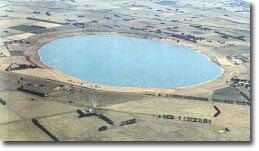Lake Keilambete
|
This information has been obtained from the report: Eruption Points of the Newer Volcanic Province of Victoria by Neville Rosengren. This report was published in 1994 and was prepared for the National Trust of Australia (Victoria) and the Geological Society of Australia (Victorian Division). The review of eruption points was based on an earlier unpublished manuscript Catalogue of the post-Miocene volcanoes of Victoria compiled by O P Singleton and E B Joyce (Geology Department, University of Melbourne 1970). |
| Location: | 38 12 30S 142 53 00E (external link); 7421-1-2 (Terang) 647694. 4 km NW of Terang. Keilambete Road, Hampden. |  Lake Keilambete. |
Land Tenure/Use: | Private land. Grazing and quarrying. Extensive exposures of cemented tuffs and Tertiary sediments. Quarries extract tuff and limestone. | |
Type 7: | Tuff ring and maar crater. | |
Lake Keilambete is a circular lake up to 11 m deep occupying a maar crater 2 km in diameter. It is surrounded by a basaltic tuff ring which gives a maximum enclosed crater depth of 40 m. Tertiary sediments (clayey limestone and limestone) form the bedrock and are exposed at the lake shoreline and in the lower walls of the crater. There is no stream inflow or outflow but a clayey lake floor prevents seepage loss. On-going investigations of the lake environs and lake floor materials by drilling, pollen analysis and radiocarbon dating have revealed a history of changing lake levels and salinity. Carbon dating of lake floor sediments indicates a minimum age of 30 000 years for crater formation. | ||
140+ m; 10+ m (outside walls), 40 m (inside walls). | ||
National: | The site is a rare example of an almost perfectly circular, entire crater. The tuff ring is very clear and well preserved. The lake floor deposits contain an outstanding and extensive record of palaeoclimates. This is a site of on-going research. | |
Class 2: | The tuff quarries are presently small and although interrupting the profile of the tuff ring, this is compensated for by providing exposures of bedded tuff. The future extent of quarrying needs to be defined and restricted to avoid more extensive damage to the integrity of the tuff ring. Quarry cuts at right angles to the tuff ring rather than parallel to are preferable. Overburden should not be dumped on the tuff ring. Suitable quarry faces should be retained and maintained clean of debris for educational access. | |
References: | Bowler, J.M. & Hamada, T. 1971. Late Quaternary stratigraphy and radiocarbon chronology of water level fluctuations in Lake Keilambete, Victoria. Nature 32 pp. 330-332. DeDeckker, P. 1982. Holocene ostradocs, other invertebrates and fish remains from cores of four maar lakes in southeastern Australia. Proceedings of the Royal Society of Victoria 94, pp. 183-220. | |


